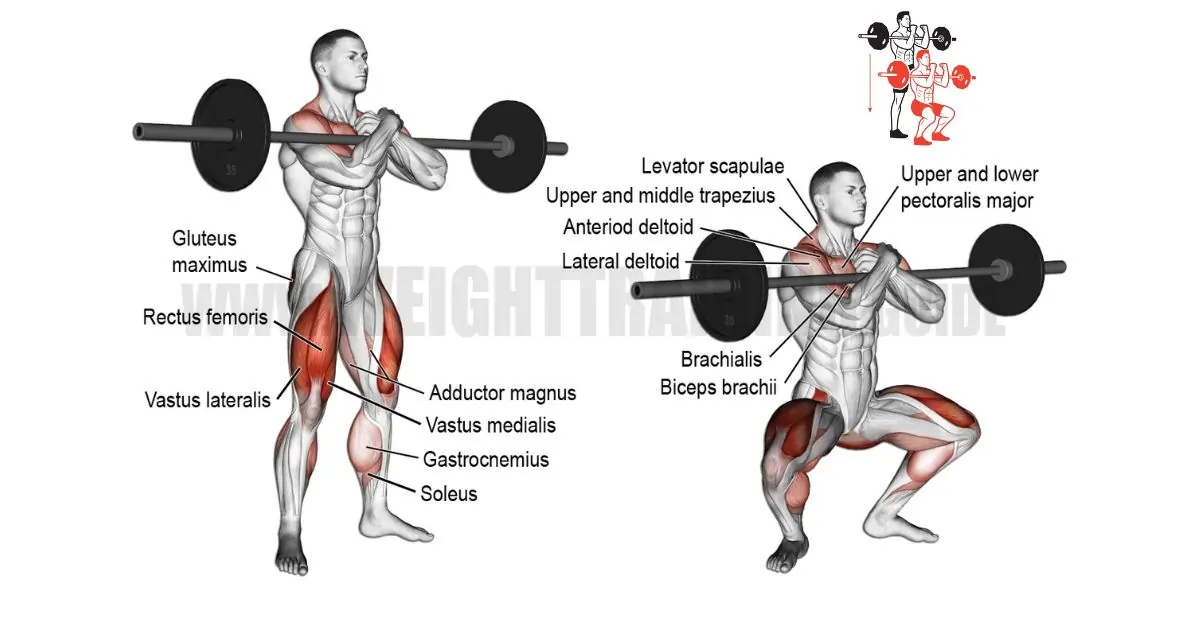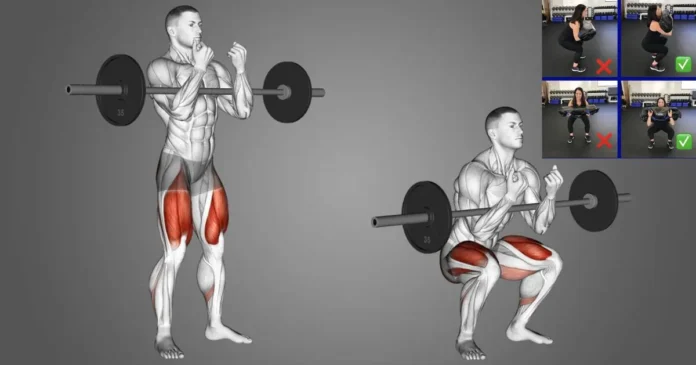Introduction – What Is the Zercher Squat and Why Does It Matter
If you’re looking for an exercise that challenges your body in a completely new way, the Zercher Squat might be exactly what you need.
Unlike the traditional back or front squat, this lift positions the barbell in the crook of your elbows, forcing your core, upper back, and legs to work together in a deeply functional way.
People usually search for the Zercher Squat because they want:
- To improve core strength and posture.
- To explore strongman-style lifts for functional power.
- Or simply to find a variation that feels safer on the shoulders and wrists.
This squat variation may look unconventional, but it’s a game-changer for real-world strength. Whether you’re an athlete, powerlifter, or beginner, learning how to Zercher Squat safely can unlock new levels of stability, balance, and strength.
The Origin and Purpose of the Zercher Squat
The Zercher Squat is named after Ed Zercher, a 1930s strongman from Missouri. At that time, not every gym had racks or lifting equipment. Ed invented this method by picking up a barbell from the floor and cradling it in his elbows — a creative solution that built tremendous functional power.
Over time, athletes discovered that this style didn’t just build leg strength; it also developed bracing control, spinal stability, and grip endurance.
Today, coaches still include it in strongman programs, CrossFit routines, and athletic conditioning.
Why? Because it mimics real-life lifting situations — carrying heavy objects in front of your body, such as lifting a box, sandbag, or even a person.
The purpose of the Zercher Squat isn’t just to get stronger — it’s to train your body for practical, everyday strength that supports better posture, injury prevention, and athletic performance.
Muscles Worked in the Zercher Squat
The Zercher Squat activates nearly every major muscle in the body. Here’s a quick breakdown:
| Muscle Group | Role in Zercher Squat |
| Quadriceps | Primary movers during the squat descent and ascent. |
| Glutes | Powerhouse for hip extension at the top of the lift. |
| Hamstrings | Support hip stability and assist in standing upright. |
| Core (Abs & Obliques) | Keep your torso upright and protect your spine. |
| Upper Back (Traps & Rhomboids) | Maintain posture and control the front-loaded weight. |
| Biceps & Forearms | Stabilize and hold the barbell securely in the elbows. |
Unlike back squats that focus heavily on the posterior chain, the Zercher Squat spreads the effort across both front and rear muscle chains, improving total-body coordination.
Because the bar is placed in front, your core and upper back are forced to resist forward collapse — making it one of the best squats for core endurance and spinal alignment.
How to Perform the Zercher Squat (Step-by-Step Guide)
Performing a Zercher Squat may feel awkward at first, but mastering the setup ensures maximum benefits and safety.

Step-by-Step Technique
- Set the Barbell:
Position it in a squat rack at waist height. This allows an easy lift-off without straining your back. - Get into Position:
Step close, loop your arms under the bar, and hold it securely in the bend of your elbows. Clasp your hands or interlock fingers for support. - Brace Your Core:
Tighten your abs and lift your chest before stepping back. Keep your feet shoulder-width apart. - Begin the Descent:
Sit back and down as if sitting in a chair. Keep your elbows tight against your torso and chest upright. - Drive Up:
Push through your heels, extend your hips, and return to a standing position without rounding your back.
Common Mistakes to Avoid
- Rounding your spine or letting the bar drift forward.
- Holding the bar too high or low in the elbows.
- Neglecting your breathing — always brace before descending.
When done properly, the Zercher Squat teaches control, balance, and deep stability in a way few other exercises can.
Benefits of the Zercher Squat
The Zercher Squat offers a unique set of advantages that extend far beyond leg development.
🔹 1. Builds Superior Core Strength
Because the bar is positioned in front, your abs and obliques work overtime to stabilize your torso. It’s one of the most effective lifts for real-world core engagement.
🔹 2. Improves Posture and Back Health
Unlike the back squat, this lift trains your upper back and spinal erectors to stay upright under load, improving overall posture and reducing back strain.
🔹 3. Functional Strength and Mobility
It simulates lifting heavy objects from the front — improving coordination, grip, and mobility. This makes it a practical exercise for athletes, firefighters, and manual laborers.
🔹 4. Less Shoulder Stress
Since there’s no bar resting on your shoulders, it’s ideal for those with shoulder or wrist discomfort who still want to squat heavy.
🔹 5. Full-Body Engagement
Every rep challenges your legs, arms, back, and core, making it an efficient compound movement that burns more calories and enhances muscular balance.
Zercher Squat vs. Front Squat – Key Differences
| Feature | Zercher Squat | Front Squat |
| Bar Position | Cradled in the elbows | Rest on the front deltoids |
| Core Activation | Very high | Moderate |
| Comfort | Less comfortable but stable | Easier on arms |
| Load Capacity | Slightly lower | Higher potential load |
| Training Focus | Functional and full-body | Quadriceps dominant |
🧠 When to Choose Each
- Use Zercher Squats if your goal is core stability and functional strength.
- Choose Front Squats if you want maximum leg hypertrophy and a smoother rack position.
Many athletes rotate between both to balance strength and comfort while improving posture and mobility.
Programming the Zercher Squat: Sets, Reps, and Load
The Zercher Squat can be tailored for beginners or advanced lifters.
Here’s a simple programming guide:
Beginners
- 3 sets of 6–8 reps
- Focus on learning bar placement and core bracing.
Intermediate Lifters
- 4 sets of 5–6 reps
- Increase load gradually; aim for form over weight.
Advanced Lifters
- 5 sets of 3–5 reps
- Great for building maximal strength and endurance.
💡 Tip: Start with around 40–50% of your back squat max. Progress as your comfort and elbow strength improve.
Include it 1–2 times per week in lower-body or full-body sessions for the best results.
Zercher Squat Variations and Alternatives
You can spice up your training with these Zercher-inspired variations:
- Zercher Deadlift: Lift the barbell from the floor to your elbows — perfect for developing starting power.
- Zercher Lunge: A single-leg variation that boosts balance and coordination.
- Zercher Carry (Strongman Style): Walk while holding the bar in your elbows — a brutal test of core and grip strength.
- Goblet Squat: Great alternative for beginners, using a dumbbell instead of a barbell.
Each variation can improve different aspects of strength, making your training more dynamic and well-rounded.
Common Mistakes and How to Avoid Them
Even experienced lifters make errors with this lift. Watch out for:
- Poor Posture: Keep your chest tall; don’t round your spine.
- Incorrect Bar Height: Too high strains shoulders; too low limits mobility.
- Going Too Heavy Too Fast: Start light until elbows adapt.
- Neglecting Warm-Ups: Always prepare your core and lower back before heavy Zercher sets.
Fixing these small mistakes ensures safer progress and long-term gains.
Safety Tips and Equipment Recommendations
- Use a Bar Pad or Towel: Protect your elbows from discomfort.
- Flat Shoes Only: Heels can shift your balance forward.
- Brace Your Core: Inhale deeply before every rep.
- Avoid Locking Knees: Keep a soft bend at the top of the movement.
If you’re training alone, practice unracking and re-racking with light weight first. Safety always comes before ego.
Who Should Try the Zercher Squat?
The Zercher Squat isn’t just for powerlifters. It’s suitable for:
- Athletes who need explosive strength and control.
- Functional trainers who want realistic, full-body power.
- Lifters without racks who can start from the floor.
However, if you have elbow, lower back, or shoulder injuries, start with alternatives like Goblet Squats or Front Squats before progressing.
FAQs
Q1: What muscles does the Zercher Squat work?
It targets your legs, core, upper back, and arms, making it a full-body compound exercise.
Q2: Is the Zercher Squat better than front squats?
Not necessarily — it depends on your goal. Zercher Squats are more functional, while front squats focus more on leg hypertrophy.
Q3: Can beginners do the Zercher Squat?
Yes! Start light and focus on form. Use a towel or pad for elbow comfort.
Q4: How can I avoid elbow pain?
Use padding, and don’t hold the bar too tight — balance it naturally in the elbow crease.
Q5: How heavy should I go?
Start with 40–50% of your back squat max, and progress as your comfort improves.
Conclusion – Why the Zercher Squat Deserves a Place in Your Training
The Zercher Squat is more than just a quirky lift — it’s a powerful tool for building functional, real-world strength. It challenges your core, upper back, and legs while improving posture, balance, and endurance.
For anyone who wants to develop a strong, stable, and resilient body, this movement offers unmatched benefits.
Start light, perfect your form, and experience how this old-school exercise transforms modern fitness training.
Similar articles:

